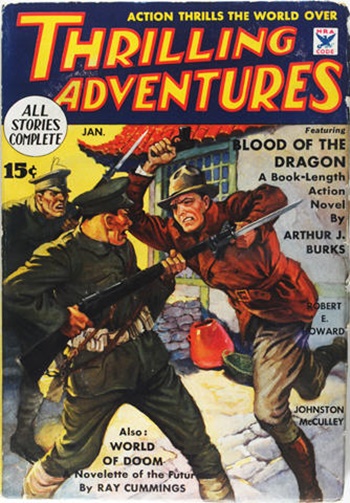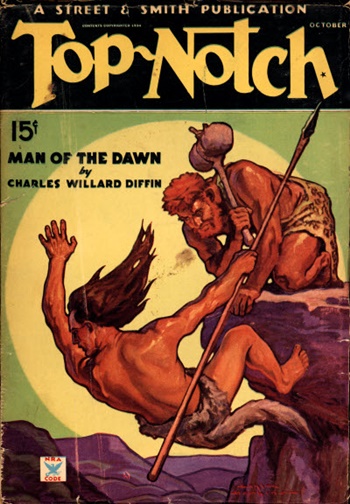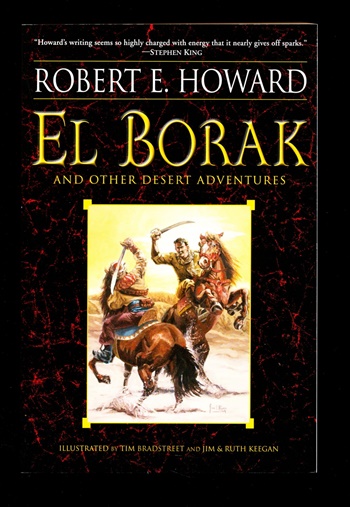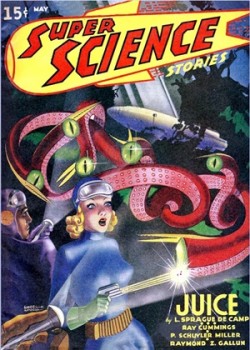A (Black) Gat in the Hand: Thrilling Adventures from Robert E. Howard
 “You’re the second guy I’ve met within hours who seems to think a gat in the hand means a world by the tail.” – Phillip Marlowe in Raymond Chandler’s The Big Sleep
“You’re the second guy I’ve met within hours who seems to think a gat in the hand means a world by the tail.” – Phillip Marlowe in Raymond Chandler’s The Big Sleep
(Gat — Prohibition Era term for a gun. Shortened version of Gatling Gun)
Two weeks ago, we followed Robert E. Howard out of our usual mean streets, and into the Shudder Pulps. Two-Gun Bob was our tour guide again last week, as we wandered into Spicy Adventures territory. Howard is a great guide through the pulps, and this week, Kirby O’Donnell takes us to the Adventure Pulps.
Robert E. Howard sold his first story in 1925, with “Spear and Fang” appearing in the July issue of Weird Tales. One of Howard’s first characters, written as a young teen, was a Texas gunslinger who roamed the wilds of Afghanistan and neighboring areas. Francis Xavier Gordon, who would be better known as El Borak (The Swift) was Howard’s attempt to get into the higher paying, prestigious pulps, like Argosy, and Adventure.
Unfortunately, that turned out to be an unassailable market for Howard, and he did not get his first adventure story published until late 1934. At the peak of his writing skill, he would, sadly, be dead in less than two years. And it wasn’t a more developed El Borak that got Howard into the market. It was a very similar, less complex character named Kirby O’Donnell.
My REH friend Dave Hardy has written two excellent articles on El Borak and Howard’s gunslingers of the Near East. The definitive essay on the topic is in the Del Rey El Borak and other Adventures collection. And you can find the other here at Black Gate, in our Discovering Robert E. Howard series.
Howard could not find a home for his refined El Borak stories. Kirby O’Donnell was a similar character. He was an Irish-American cowboy who went native in Afghanistan. He rarely spoke English and was taken to be a Kurd. But where El Borak was serving a cause, O’Donnell was a treasure hunter. That is the key difference between the two when we first meet each man.
O’Donnell features in three stories. Top-Notch Magazine ran “Swords of Shahrazar” in the October 1934 issue. But that was the second of two related stories. They didn’t bother to buy the first – “Gold From Tartary.” So, the second story was printed first. While “Gold’ would appear in Thrilling Adventures three months later, in January 1936. Screwy.
Sadly, “The Trail of the Blood-Stained God” didn’t find it’s way into print until 1976. Although, L. Sprague de Camp rewrote it as a Conan adventure, “The Blood-Stained God.” It would also be used for an issue of The Savage Sword of Conan.
I think that “Swords” is a terrific story, and among Howard’s best. It is twice as long as the other two O’Donnell tales, and is a direct sequel to “Gold.” I prefer the El Borak tales, but “Sword” is a rousing adventure, and Howard at his peak.
Top-Notch Magazine started way back in 1910 as a magazine for boys; mostly with sports stories. Became Top-Notch. Then back to Top-Notch Magazine. Then Street & Smith’s Top-Notch Magazine. It was under that title that it made the switch to men’s adventure stories in June of 1930. Not THAT kind of ‘Adult’: just not kid’s stories any more. More name changes would follow.
 But it was this shift to the Adventure Pulp market that would result in Howard selling his first Adventure story. Top-Notch would publish about 600 issues, from 1910 to 1934. The Great Depression killed it not long after the switch to Adventure Pulp.
But it was this shift to the Adventure Pulp market that would result in Howard selling his first Adventure story. Top-Notch would publish about 600 issues, from 1910 to 1934. The Great Depression killed it not long after the switch to Adventure Pulp.
It’s a shame, as it would include El Borak stories in December 1934 (“The Daughter of Erlik Khan”), June 1935 (‘Hawk of the Hills,” and July 1935 (“Blood of the Gods”). Along with “Swords of Shahrazar,’ that was four stories in less than a year. He would sell a few more. While he was still struggling (“Three-Bladed Doom,” a favorite of mine, never did find a home), he was breaking into a new market at the same time Weird Tales was not paying him for published work. Along with his popular Westerns, perhaps the Mystery and Adventure Pulps might have kept him going on.
Thrilling Adventures published the first O’Donnell story, which the second one directly flows out of. Who knows how many folks who read “Swords of Shahrazar,” then read the first story, a few months later?
Thrilling Adventures was created in December 1931 by Pulp maven Leo Marguiles. It was his attempt at grabbing some of Adventure magazine’s market. It was monthly until 1943, when it went to bi-monthly. It folded that same year. It would publish an El Borak story in December of 1936. “Son of the White Wolf” saw print six months after Howard killed himself.
It never surpassed Adventure, but it did have a few big names between its covers, including Edgar Rice Burroughs, Louis L’Amour, and L. Ron Hubbard. Arthur J. Burks, a prolific Adventure Pulp writer, was a frequent contributor.
El Borak vies with Conan as my favorite Robert E. Howard character – and the Del Rey collection is a stellar book. The ebook is on sale on Amazon for $6.99 as I type this. That is a STEAL!
Howard had mastered his craft when he wrote these Adventure stories, having honed it with Conan, Solomon Kane, and his historicals. O’Donnell is different than El Borak, but is definitely pretty similar and you can generally lump the two together in discussion.
In an essay on tough guy Race Williams, I commented that Carroll John Daly took the Wild West and transplanted it to the urban city, in fashioning the hardboiled genre. Howard took the Wild West and moved it to the Wild East. El Borak and O’Donnell are wandering cowboys – but their mountains and deserts aren’t in the American Southwest. Instead of Indians, they battle tribesmen from the hills and plains. Pistols (not six-shooters, though) and rifles are aided by tulwars and scimitars.
Substitute the band of rogues in “Swords” with Mexican bandidos, in the foothills and mountains of the Southwest. The streets of Shahrazar are every bit as mean as those of New York City or Chicago. Different factions compete for control of cities, and empires.
Howard was well-read on the region, and of course, he knew how to write exotic locales. His prose makes these far more than cowboy stories with an Eastern veneer laid over them.
SPOILER ALERT – This story is almost ninety years old. And the Del Rey collection is easily available. I’ll try not to be too blatant, but you’ve had plenty of time to read these stories. And you should – they’re excellent!
“Gold from Tartary” is an unusual treasure-hunting story, in that the entire thing takes place in basically two places, close by in a city. O’Donnell is walking down a dark alley in Forbidden Shahrazar when he comes upon a brawl and sees Yar Akbar, a hated personal enemy. His Scottish blood boiling, he jumps into the fight, where one man is fighting off several.
Howard is a master at combat scenes. There is much swordplay in El Borak and O’Donnell, and it’s always a treat to read. Jumping into the fray,
“His long, narrow, curved blade, licked venomously at this figure, ploughing through cloth, bringing a yelp as the edge sliced skin. Something crashed down on O’Donnell’s head, gun butt or bludgeon and he reeled, his eyes full of sparks, and closed with someone he could not see.
His groping hand locked down on a chain that encircled a bull neck, and with a straining gasp he ripped upward and felt his keen kindhjal (a long, narrow, curved blade) slice through cloth, skin, and belly muscles. An agonized groan burst from his victim’s lips, and blood gushed sickeningly over O’Donnell’s hand.”
 That is the fourth paragraph of the story! He jumped into the fight in the third. Howard starts this story by kicking down the door. And his dazzling prose is on display right away. The first chapter of “The Trail of the Bloodstained God” is even more of a rocket ride.
That is the fourth paragraph of the story! He jumped into the fight in the third. Howard starts this story by kicking down the door. And his dazzling prose is on display right away. The first chapter of “The Trail of the Bloodstained God” is even more of a rocket ride.
O’Donnell rips a necklace off of the man he killed, before the opponents flee. The man he rescued thanks him, does not give his name, and disappears.
O’Donnell can pass completely as a Kurd, which is an ethnic group in Turkey. He is the first Westerner to ever set foot in Shahrazar. There was an epic treasure (think National Treasure) hidden away in the city long before. Shaibar Khan, the current ruler, had found it, though it was a secret. O’Donnell had snuck into the city to find that treasure.
O’Donnell goes to Ayisha’s house, which seems to be some type of den of intrigue. Howard rather heavy-handedly does an info dump about the necklace – hey, the guy wasn’t perfect! The necklace gives him entry into the palace, where the rest of the story takes place.
This is a treasure hunt that basically takes place in just one location. Which is fine. But a bit different. O’Donnell’s disguise is penetrated by no one as he searches for the gold, in the palace. He even ends up serving directly for Ahmed Pasha, Shaibar Khan’s vizier. In doing that task, he ends up overhearing a conversation – entirely in English! – in which some European power would set Asia aflame and set up an empire. And the gold of Tartary would pay for the needed swords.
There’s a terrific sword fight on a stairway. It’s not the refined, Errol Flynn type of fight. This is raw, harsh, for survival:
“He met the first attacker, a hairy Pathan, with a long lunge that sent his scimitar point though the thick throat even as the man’s broad tulwar went up for a stroke. Then a tall Uzbek swung his heavy blade like a butcher’s cleaver. No time to parry; O’Donnell caught the stroke near his own hilt, and his knees bent under the impact.
But the next instant the kindhjal in his left hand ripped through the Uzbek’s entrails, and with a powerful heave of his whole body, O’Donnell hurled the dying man against those behind him, bearing them back with him. Then O’Donnell wheeled and ran, his eyes blazing defiance of the death that whickered at his back.”
This is breathless reading. I’m a Solomon Kane fan, and those sword fights are excellent. But there’s something primal, and fierce, in these Desert Adventures. Howard truly was terrific at this. Another decade of these types of stories would have been marvelous.
I mentioned SPOILER ALERT, right?
The city comes under attack from an army of Turkomen, led by a strong chief named Orkhan Bahadur. He too seeks the fabled treasure. He manages to breach the city, and O’Donnell finds the treasure room! It’s a massive hoard, and he kills Shaibar Khan and Yar Akbar in the process. O’Donnell, the treasure hunter, fears that the dark stranger could somehow carry out his plans using Bahadur, rather than Shaibar Khan. He can’t risk the chief finding it. O’Donnell had learned a lever on the wall tilted the floor, to dump the treasure into the river running below the fortress. Gritting his teeth, he pulls it, and the massive pile of gold vanishes. We’ve seen his character evolve. O’Donnell is no longer just an adventurer, looking for treasure. He sacrifices his goal for the betterment of society. We will see that furthered in the next story (which, of course, had already been published).
He flees the room and runs into a band of the invaders. Before they can shoot him, Bahadur himself halts them. For Bahadur is the stranger who O’Donnell saved in the opening scene! He had snuck in to scout the city. He declares O’Donnell (whose name he knows as Ali El Ghazi) his cup companion. He promises him anything. Even a share of the treasure, when they find it!
One suspects Bahadur might not be quite so friendly if he knew what O’Donnell had done.
This story is a fast read, and I like it. “Swords of Shahrazar takes place ‘out in the wild,’ and Howard’s descriptive prose shines through. I really love his scenery description in the Conan and El Borak tales. He really was as good with words as anyone I read. Since it’s a sequel to “Gold,” you can definitely read them back-to-back.
Robert E. Howard’s life – and death – are a litany of ‘What ifs?’ I do believe he had finished with Conan, and Westerns were his immediate future, when he killed himself. But he did sell some stories with El Borak, Kirby O’Donnell, and one with a somewhat similar character, Steve Clarney. Sure – some weren’t published until long after he died. But not all of his Conan stories were purchased and published. I mean, we’re talking CONAN!
What if he had continued writing? And he kept trying to sell El Borak? Maybe, somehow, “Three-Bladed Doom” would have found a home. And we’d have seen more of O’Donnell and El Borak. Yeah, probably not. But this Del Rey collection is as fine a Pulp volume as I own. They are just totally rousing adventure stories from a first-rate writer.
I’m slightly over-simplifying, but there are a dozen stories in this Del Rey collection. Seven of them were published after his death. So, several were not even available for a long time. I have read the three Kirby O’Donnell stories each many times, and they never fail to entertain. Check them out.
Prior posts in A (Black) Gat in the Hand – 2022 Series (4)
Asimov – Sci Fi Meets the Police Procedural
The Adventures of Christopher London
Weird Menace from Robert E. Howard
Spicy Adventures from Robert E. Howard
Prior posts in A (Black) Gat in the Hand – 2021 Series (7)
Norbert Davis
Appaloosa
A (Black) Gat in the Hand is Back!
Black Mask – March, 1932
Three Gun Terry Mack & Carroll John Daly
Bounty Hunters & Bail Bondsmen
Norbert Davis in Black Mask – Volume 1
Prior posts in A (Black) Gat in the Hand – 2020 Series (19)
Hardboiled May on TCM
Some Hardboiled streaming options
Johnny O’Clock (Dick Powell)
Hardboiled June on TCM
Bullets or Ballots (Humphrey Bogart)
Phililp Marlowe – Private Eye (Powers Boothe)
Cool and Lam
All Through the Night (Bogart)
Dick Powell as Yours Truly, Johnny Dollar
Hardboiled July on TCM
YTJD – The Emily Braddock Matter (John Lund)
Richard Diamond – The Betty Moran Case (Dick Powell)
Bold Venture (Bogart & Bacall)
Hardboiled August on TCM
Norbert Davis – ‘Have one on the House’
with Steven H Silver: C.M. Kornbluth’s Pulp
Norbert Davis – ‘Don’t You Cry for Me’
Talking About Philip Marlowe
Steven H Silver Asks you to Name This Movie
Cajun Hardboiled – Dave Robicheaux
More Cool & Lam from Hard Case Crime
A (Black) Gat in the Hand – 2019 Series (15)
Back Deck Pulp Returns
A (Black) Gat in the Hand Returns
Will Murray on Doc Savage
Hugh B. Cave’s Peter Kane
Paul Bishop on Lance Spearman
A Man Called Spade
Hard Boiled Holmes
Duane Spurlock on T.T. Flynn
Andrew Salmon on Montreal Noir
 Frank Schildiner on The Bad Guys of Pulp
Frank Schildiner on The Bad Guys of Pulp
Steve Scott on John D. MacDonald’s ‘Park Falkner’
William Patrick Murray on The Spider
John D. MacDonald & Mickey Spillane
Norbert Davis goes West(ern)
Bill Crider on The Brass Cupcake
A (Black) Gat in the Hand – 2018 Series (32)
George Harmon Coxe
Raoul Whitfield
Some Hard Boiled Anthologies
Frederick Nebel’s Donahue
Thomas Walsh
Black Mask – January, 1935
Norbert Davis’ Ben Shaley
D.L. Champion’s Rex Sackler
Dime Detective – August, 1939
Back Deck Pulp #1
W.T. Ballard’s Bill Lennox
Day Keene
Black Mask – October, 1933
Back Deck Pulp #2
Black Mask – Spring, 2017
‘Max Allen Collins & The Hard Boiled Hero’
A (Black) Gat in the Hand: William Campbell Gault
A (Black) Gat in the Hand: More Cool & Lam From Hard Case Crime
MORE Cool & Lam!!!!
Thomas Parker’s ‘They Shoot Horses, Don’t They?’
Joe Bonadonna’s ‘Hardboiled Film Noir’ (Part One)
Joe Bonadonna’s ‘Hardboiled Film Noir’ (Part Two)
William Patrick Maynard’s ‘The Yellow Peril’
Andrew P Salmon’s ‘Frederick C. Davis’
Rory Gallagher’s ‘Continental Op’
Back Deck Pulp #3
Back Deck Pulp #4
Back Deck Pulp #5
Joe ‘Cap’ Shaw on Writing
Back Deck Pulp #6
The Black Mask Dinner
 Bob Byrne’s ‘A (Black) Gat in the Hand’ made its Black Gate debut in 2018 and has returned every summer since.
Bob Byrne’s ‘A (Black) Gat in the Hand’ made its Black Gate debut in 2018 and has returned every summer since.
His ‘The Public Life of Sherlock Holmes’ column ran every Monday morning at Black Gate from March, 2014 through March, 2017. And he irregularly posts on Rex Stout’s gargantuan detective in ‘Nero Wolfe’s Brownstone.’ He is a member of the Praed Street Irregulars, founded www.SolarPons.com (the only website dedicated to the ‘Sherlock Holmes of Praed Street’) and blogs about Holmes and other mystery matters at Almost Holmes.
He organized Black Gate’s award-nominated ‘Discovering Robert E. Howard’ series, as well as the award-winning ‘Hither Came Conan’ series.
He has contributed stories to The MX Book of New Sherlock Holmes Stories – Parts III, IV, V, VI and XXI.
He has written introductions for Steeger Books, and appeared in several magazines, including Black Mask, Sherlock Holmes Mystery Magazine, The Strand Magazine, and Sherlock Magazine.
Great write-up, Bob! I can easily see your love for Kirby O’Donnell in it! While I agree that Howard was turning to writing mostly westerns, boxing stories, and adventures for the better pay on acceptance at this stage of his career, I wonder if the fact that he had hired Otis Kline as his agent, who was placing him in these better-paying markets, may have had an influence on his shift in writing-subjects? Also, there are a few letters from Kline and some of these pulp editors to Howard that still exist where they help give him critiques on his writing and the types of stories they’re looking for that may have also had an influence on what he wrote.
Thanks, John. I literally have no interest in the Adventure Pulp genre. Just not my thing. But that El Borak book absolutely sucked me in! I so loved all the stories. I re-read that more than any Del Rey (though I listen to Conan on audiobook a fair amount).
Fight Stories folding in 1932 (to reappear in 1936) probably didn’t help, as that steady market dried up. And Weird Tales wasn’t paying what they owed. And he was done with Conan. It certainly seemed like an opportune time to make a splash in the Adventure pulps. Too bad neither Adventure, or Argosy, bought from him.
I’ll probably write about the Clarney story some time, since it’s just the one.
I’m struggling with the Foundation collection of El Borak. They just aren’t very well written. Or goo stories. They almost read like travelogues, or diary accounts. He hadn’t become a skilled writer yet. Which is fine!
But that Del Rey book. And Dave Hardy’s amazing afterword. I do enjoy it.
Yes, I agree that “The Early Adventures of El Borak” is not a page-turner. Most of Howard’s juvenile stories are interesting in an historical, watch his evolution as a writer, way, and probably should only appeal to completists and scholars. It is a shame that some person in Hollywood never took the idea that the artist used Thomas Jane as his model for the illustrations in the Del Rey book and made a movie or two out of the stories with Jane as Gordon. Those illustrations always tickle me with their sheer entertainment value.
Hmm…I think Borak would have been fun in that old B-movie Western. Not everything has to be a Marvel epic. They’d be cool minor movies, or a weekly, back in the fifties.